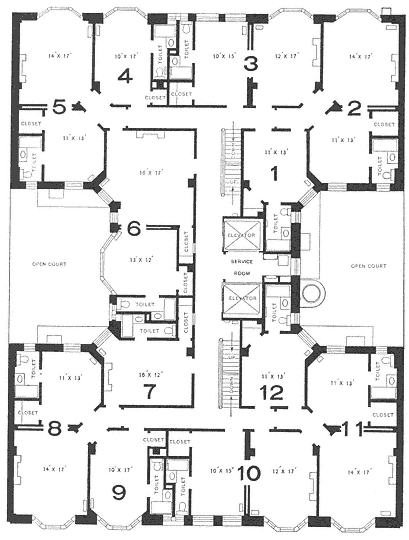Links to the Tourist's and Shopper's Downtown
If the palace hotel was usually surrounded by some of the city's most exclusive boutiques, the midpriced hotel was usually close to the city's best department stores and reasonably close to the financial district. After 1910 in San Francisco, sojourners could find the most densely clustered midpriced hotels along Bush and Sutter streets between Powell and Jones. Depending on one's point of view, this small area was called lower Nob Hill or upper Union Square. The area contained almost a third of the city's midpriced hotel rooms and a large number of coffee shops and gift emporiums. Most hotels advertised for tourists, but they also listed themselves as "a home in a hotel" or "a residential hotel on an ideal residential street" (fig. 3.13).[53]
Although the self-image of the residents and hotel managers of these blocks revolved around the elites on Nob Hill, their daily lives revolved around Union Square. The square itself was a place to sit and watch
urban life. Nearby theaters and evening shopping lent a respectable nightlife to the streets. Grills and restaurants ranged in price from the expensive to the very cheap, making dining out easy and varied. It was a pleasant neighborhood for the middle-income person who wanted to be in the middle of the city's action.
According to the local myth, the hotels of Bush and Sutter streets, along with the nearby streets of the Tenderloin area, were built for tourists coming to the city's Panama-Pacific International Exposition in 1915. Every large city has similar rumors about the role of special events, and the rumors require debunking. Indeed, for midpriced hotels (and for palace hotels, too), travelers were always the primary market. In San Francisco, tourism became a major industry early in the city's history, and convention trade boomed with the advent of reasonable railroad rates. In 1897, the Southern Pacific Railroad helped to lure over 20,000 people for the Christian Endeavor Society convention. In 1904, the Triennial Conclave of the Knights of Templar brought 19,000 participants. These spikes of tourist dollars boosted the profits of hotels and other businesses more obviously than the steady stream of other travelers. In 1910, members of San Francisco's Chamber of Commerce announced ambitious plans for the Panama-Pacific International Exposition, to be held in 1915. The exposition would celebrate the opening of the Panama Canal and prove that the city had fully recovered from its earthquake and fire of 1906.[54] As a direct result of the exposition announcement, many San Franciscans did build new hotels between 1910 and 1915. For the owner of a new hotel, the exposition guaranteed a year of total occupancy at maximum rates and enough profits to repay short-term construction loans. However, no one purposely built a sixty-year structure for only one year of business—not in San Francisco or any other city. In the long term, spurts of hotel construction like these were responses to downtown business growth. When the Panama-Pacific crowds went home, managers at the dozens of new 100-room hotels in San Francisco's Bush Street and Tenderloin neighborhoods knew they could rent rooms permanently to a combination of tourists and workers in the expanding downtown office sector. Floor plans of many downtown hotels show how their configurations could be shifted from one-room units to five-room units to match seasonal or occasional changes in the market (fig. 3.14). However, in San Francisco as in other cities, people of middle incomes who wanted

Figure 3.14
Plan of a typical floor in the Algonquin Hotel, New York City.
Accommodations could range from one room to five-room corner suites.
to live downtown were not forced to accept life around Union Square in a classic midpriced hotel. By 1900, developers offered a range of other rental housing options in both hotels and apartments.